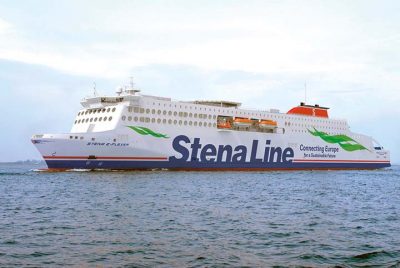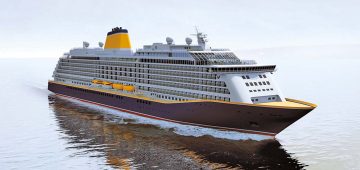Quartet For Stena Line
In 2016 Stena Line announced a newbuild contract of four Ro-Pax ferry vessels with a planned delivery schedule during 2019 and 2020. The contract also contained an option for another four vessels to be ordered. The newbuild quartet are being built at the AVIC Shipyard in China and, as announced on 15th February, the plan is to locate the vessels on the Irish Sea, specifically on Stena Line’s routes to and from its expanding Belfast hub.
Stena Line’s 64,039gt/2010 built Stena Hollandica (above) proceeded to dry dock at Rotterdam on 25th February and was replaced by the 33,690gt/2011 built Killingholme-Hoek van Holland ship Stena Transporter until the Harwich ship resumed service on 9th March. The ‘Transporter’ was replaced at Killingholme by the 13,017gt/1996 built Stena Scotia. The latter was herself replaced by the ubiquitous 7,606gt/1998 built Arrow on a sub-charter from the IoMSPCo, following winter lay up in Larne, on the Killingholme-Europoort service. The 20,028gt/1982 built former Stena Line train ferry Trelleborg (now the Sunny) was scheduled to leave Greece in early March to start a new life in the Arabian Gulf.
Faster Viking
The Helsinki-Tallinn route is becoming increasingly popular and attracts leisure and business travellers as well as foreign tourists. Viking Line is responding to this strong demand by adding a new service option in the form of the 5,902gt/1998 built Viking Faster, or FSTR, which will serve the route during the period 10th April-22nd October. The ‘new’ vessel is a 91m catamaran that will cross the sea between Helsinki and Tallinn in 1hr 45mins and may be more familiar to readers as P&O Ferries’ Portsmouth Express/Cherbourg Express/ Express. She served Portsmouth- Cherbourg 2000-2004 having been built as the Catalonia for Buquebus. The vessel then moved to Cairnryan-Larne 2005-2015 and was sold to Gotlandsbåten for further service in 2016. The latter venture was unsuccessful so Viking Line has now taken the craft on.

New Ro-Ro Blossoms
On 17th February the latest DFDS Seaways Ro-Ro vessel, the 32,000gt Gardenia Seaways (Yard No. 772), was launched as the first of two new vessels from the Flensburger Schiffbau-Gesellschaft shipyard. The 210m long ship will have capacity for 262 trailers and a load space of 4,076 m. Both ships are set to enter service on DFDS lines in the North Sea, boosting capacity by 20%. The Gardenia Seaways is expected to be handed over in May under a bareboat charter contract to join the Rotterdam-Immingham route.
Balmoral Secured For 2017
On 27th February came the news that, after a very long and detailed meeting by MVBFL trustees concerning every aspect of the 735gt/1949 built Balmoral’s future, a unanimous decision had been made to push ahead and make plans to sail this summer. While there are challenges ahead it was felt that the report from the technical managers was favourable and that sufficient funding was in place to meet expected dry-docking costs at Sharpness, and other start-up costs, with reasonable provision for contingencies. The Balmoral goes to Sharpness during the first week in May but fundraising must continue to secure extra donations before that to cater for any serious and unexpected expenditure which might arise. A new and varied timetable is in place for 2017 and will be available in early spring. The season begins with an evening music cruise on 26th May, departing Clevedon 1815 and Portishead 1900 for a trip under the Severn Bridges and back at 2200 and 2245. For full details, see www.whitefunnel. co.uk.
Boost For Calmac
Caledonian MacBrayne’s official carrying statistics for 2016 reveal that the west coast of Scotland ferry company passed five million passengers for the first time since 1997. The company operates the UK’s largest ferry network, with 32 vessels carrying out more than 136,000 individual sailings annually across an area which extends some 200 miles from Campbeltown on Kintyre and the Isle of Arran in the south, to Stornoway on the Isle of Lewis in the north. Many routes saw very significant rises in both passenger and car numbers in the first full year after the roll-out of road equivalent tariff (RET) across all areas, with a total of 5,055,827 passengers and 1,356,396 cars network-wide. This equates to 428,801 more passengers than in 2015 and 186,695 more cars.
RET is a Scottish Government policy to ensure that those living on an island are not unduly financially disadvantaged by ferry fares. It has had a phased introduction, beginning in 2008 with a number of Western Isles destinations and culminating with full network coverage in October 2015. The RET scheme involves setting ferry fares on the basis of the cost of travelling an equivalent distance by road. The busiest route overall in the network continues to be Ardrossan in North Ayrshire to Brodick on the Isle of Arran, carrying 828,262 people and 202,843 cars in 2016, a rise of 8.7% and 6.84% respectively. Two other Firth of Clyde routes complete the top three highest passenger totals with 738,549 (+7.49%) on Largs to Isle of Cumbrae and 675,714 (+6.97%) on the Wemyss Bay/Gourock to Rothesay on the Isle of Bute route.
In terms of cars, the Rothesay route was second with 172,897 (+19.12%), with Oban to Craignure on the Isle of Mull showing a 40.66% rise to 162,288. This route was the fourth busiest for passengers carrying 644,827 (+16.14%). The highest increase on a 2015-2016 like-for-like route was a substantial 74.09% rise in cars on the Tobermory to Kilchoan crossing and 52.26% and 52.33% on both the Oban to Lismore and the Mallaig to the Small Isles runs respectively. A larger vessel will operate the Tobermory-Kilchoan crossing this summer to help cater for the growth in numbers. In terms of largest percentage increases in passengers, Tarbert on Loch Fyne to Portavadie recorded 35.53%, with 29.61% and 21.87% on Tobermory to Kilchoan and Oban to Lismore respectively. There is evidence on a number of routes to suggest that the substantial reduction in fares has led to islanders journeying more and taking a car with them when prices had previously been seen as an inhibitor.
Solent News
In mid-February the Red Jet 3 commenced her annual survey and refit on the Isle of Wight via a contract with Wight Shipyard Ltd. to carry out the work at The Columbine Building in East Cowes, marking the first time the vessel has been refitted on the Island since she was built by FBM Marine. Brittany Ferries, Condor Ferries and Wightlink services were again disrupted on the morning of 22nd February when Portsmouth Harbour was closed following the discovery of another 500lb unexploded ordnance in the harbour. The exclusion zone meant that the harbour was closed to all traffic (with road & rail also affected) from around 0345 until 0800. The inward bound Baie de Seine, Bretagne, Commodore Clipper and Normandie were all delayed and had to wait off the east side of the Isle of Wight until the harbour reopened. Wightlink’s St. Clare was also confined to Fishbourne on the Island until after 0800. This severely impacted on daily deliveries to the IoW with a day’s postal deliveries being lost.







Comments
Sorry, comments are closed for this item